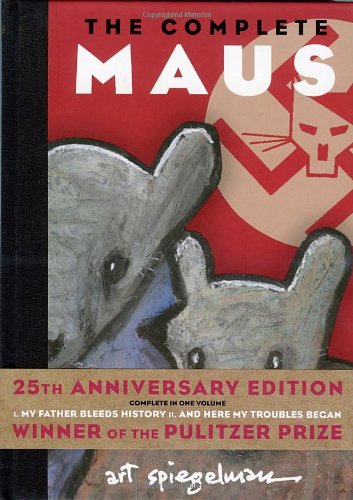"While we
don’t have any market research, the eyes don’t lie...If you go to
conventions and comic book stores, more and more female readers are emerging.
They are starved for content and looking for content they can relate to.”
In my personal experience, the eyes don't lie regarding age, either...comic readers are growing up. With a mix of young and old, male and female, comics and graphic novels now have a broad audience. Writers and artists are certain to find interest for whatever project they may create, which is allowing comics to shine through as a literary and artistic medium.

According to Christine Pyles of Public Libraries Online, Art Spiegelman was instrumental in convincing librarians that graphic novels were worth including in their collections. His genre-blending memoir, Maus, was the first graphic novel to win a Pulitzer Prize. Despite the fact that his characters are drawn as mice and cats, Maus depicts Spiegelman's interview with his father, regarding his experiences in a concentration camp during the Holocaust.
In 2004, Speigelman illustrated and wrote his second graphic novel In the Shadow of No Towers, dealing with his family's and the nation's struggle to come to terms with 9/11.
 Another notable use of the graphic novel as an autobiography is Persepolis, by Marjane Satrapi. Using comics as her medium, she tells her story of growing up and coming of age in Iran during the Islamic Revolution. Her story, which has been published internationally and well-received by critics, helps Western readers understand the conditions in Iran and humanizes its people when it's so easy to get caught up in prejudices with all the current unrest and war.
Another notable use of the graphic novel as an autobiography is Persepolis, by Marjane Satrapi. Using comics as her medium, she tells her story of growing up and coming of age in Iran during the Islamic Revolution. Her story, which has been published internationally and well-received by critics, helps Western readers understand the conditions in Iran and humanizes its people when it's so easy to get caught up in prejudices with all the current unrest and war.
Other graphic novels and comics take the fictional route to explore heavy themes. Watchmen by Alan Moore and Dave Gibbons created a gritty socio-political story that dealt with the constant anxiety of nuclear threat by up-ending the superhero genre on its head. Brian K. Vaughn's space opera Saga plays with the dynamics of war, pacifism, drug use, and familial bonds. At the beginning of this year, Kelly Sue DeConnick teamed up with Valentine DeLandro to release monthly issues of Bitch Planet, a comic exclusively developed by women and exploring feminism through a dystopian sci-fi story and essays of prominent women included on the last pages.

Artists have also used comics as a way to explore their creativity and develop their craft. Tony Moore and later Charlie Adlard, artists and inkers of The Walking Dead, experiment with pure black-and-white art to bring out the horror and stark desperation of their series. Jae Lee is another prominent artist in the horror genre, with his unique use of shadow and inking.
Adi Granov of Marvel is renowned for his digital painting style, mostly used for covers and concept art. He made his name after collaborating with Warren Ellis for Iron Man: Extremis, the storyline of which was folded into the Iron Man 3 movie.
 |
Iron
Man: Vol. 4 #8: Cover for issue #8 of Iron Man: Vol. 4.
|
References
- Tahir, Sabaa. (2014) "MS. MARVEL: Marvel Comics’ new focus on women ‘characters and creators’ aims to defy the ‘scantily clad’ cliche." The Washington Post, accessed online at http://www.washingtonpost.com/blogs/comic-riffs/post/ms-marvel-marvel-comics-new-focus-on-women-characters-and-creators-aims-to-defy-the-scantily-clad-cliche/2014/02/04/bde11f7a-8dbd-11e3-95dd-36ff657a4dae_blog.html
- Pyles, Christine. (2013) "It's No Joke: Comics and Collection Development." Public Libraries Online, accessed online at http://publiclibrariesonline.org/2013/02/its-no-joke-comics-and-collection-development/



No comments:
Post a Comment